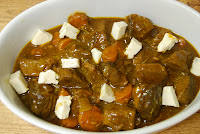listening:
“Luna” by Ed Gerhard*
Another secular feast is almost upon us. I refer to Super
Bowl Sunday. Let’s face it, for an occasion that requires food the choice of
foodstuffs often leaves a lot to be desired. I do understand the logistics; you
want to be able to pick something up and take it with you while you’re in front
of the television. But the food offerings are never as exciting as the actual
game; they are usually as forgettable as the half-time entertainment, except
for the Janet Jackson debacle.
And please, no more wings! Isn’t there a shortage this year
anyway? Let’s give the chickens a rest.
This year the game takes place in one of the major eating
cities (New Orleans) and it’s being played between two teams each with their
own home food story.
I am going to leave New Orleans for Mardi Gras (New Orleans
seems to own that event) and look at San Francisco and Baltimore, even if it
means forgoing oysters, shrimp po’ boys or fried oyster po’boys.
San Francisco is another one of our great eating cities but
choosing something distinctly of that city to serve is difficult.
Baltimore, and the entire Eastern Shore, has a rich history
with crab so why not serve crab cakes for the Super Bowl? To make it even
easier, or game friendly, make them into crab cake sliders.
This is the way I make crab cakes. I just altered the recipe
to include cracker crumbs instead of bread crumbs which I understand is the
regional twist. The crab cakes can be made in advance and warmed in the oven
before serving, which shouldn’t draw you away from the party for too long. With
the recent interest in “all things slider,” you should be able to locate small
buns for the crab cakes. While it’s not traditional, I make a spicy mayo to
wodge on top of the crab cakes if you so desire.
So what to do for San Francisco? Serve something from Anchor
Brewery, of course.
Around here “football” for our youngest daughter is that
other game played throughout the rest of the world. She would gladly pass up
the Super Bowl for a broadcast of her beloved Arsenal F.C. Go Gunners!
Crab Cake Sliders, Maryland Style
1 pound crabmeat
½ cup onion, cut into small dice
½ cup red bell pepper, cut into small dice
1 cup mayonnaise
juice of ½ lemon
2 Tablespoons chopped parsley
½ cup crushed saltine crackers (about 9 square crackers),
plus about 1 cup for forming the cakes
salt (taste and add as needed if using salted crackers) and
freshly ground black pepper
vegetable oil or a combination of vegetable oil and unsalted
butter, for cooking
1. Drain the crabmeat, if necessary. Place the crab meat
into a bowl with the onion, and bell pepper; mix to combine. In a second bowl,
mix the mayonnaise with the lemon juice. Pour this over the crab mixture, add
the parsley, and mix to incorporate. Add the crushed saltines and mix until the
crab mixture comes together. Taste and season with salt, if needed, and ground
black pepper.
2. Sprinkle another cup of crushed saltines onto a
plate. Form the crab mixture into
cakes (I used a rounded Tablespoon to fit the size of the buns I used) then roll
the crab cakes in the cracker crumbs until lightly covered. This crab cake
mixture is delicate, so work gently. This mixture should make 27 to 28 small
crab cakes.
3. Place a medium-sized nonstick sauté pan over medium-high
heat. Swirl 2 to 3 Tablespoons oil into the pan (You could also use half oil
and half butter). Place the crab cakes into the pan and cook for 4 to 5
minutes, until nicely browned. Turn the cakes and cook for another 4 to 5
minutes. Remove crab cakes from pan and drain on a paper towel lined baking
tray. Wipe the sauté pan and add fresh oil as needed. The crab cakes can be
kept on a tray then warmed in the oven before serving.
4. Lightly butter and toast the rolls before serving. Place
a crab cake onto a roll, dollop with the spicy mayo, and serve.
Spicy Mayonnaise
2/3 cup mayonnaise
juice from ½ lime
1 to 2 chipotle peppers, finely chopped (adjust to your heat
preference)
1. Place all of the ingredients into a bowl and mix until
combined. Serve with the crab cakes. Store leftover mayo in an airtight
container in the refrigerator.
*Full Disclosure: I have known Ed since high school so
perhaps I am more than a little biased. He has shaped a career as a solo
acoustic guitarist, composer, and teacher, performing both nationally and
internationally to glowing praise, wining a Grammy award and releasing nine
solo recordings along the way. He is a remarkable musician, imbued with a quiet
virtuosity that is always at the service of the music. For more about Ed,
here’s the link:http://www.virtuerecords.com/









